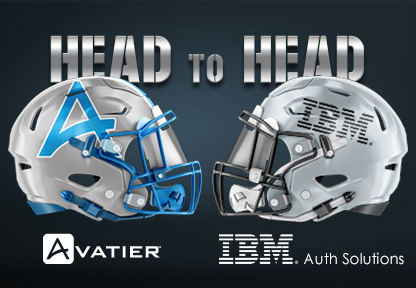You’re looking at Avatier vs. IBM Authentication Solutions for your company. How do you make a smart choice? It’s true that IBM has an excellent reputation and many years in the technology business. However, it pays to take a more critical approach in evaluating Avatier and IBM’s approach to identity and access management.
1) Avatier vs. IBM Authentication Solutions: Which Solution Is Easier For Managers?
Identity and access management software cannot succeed if it is managed in a vacuum. Specifically, you cannot expect IT to know everything required to achieve success. That’s why empowering supervisors and managers is essential. With Avatier, you have Group Requestor, which makes it easy for managers and human resources to work together to set up access based on job role. For example, a sales representative will typically need one set of access privileges while a financial analyst will need something different. This role-based approach to identity and access management matters because it reflects reality. Managers and employees think about their work in terms of job roles.
With IBM, their solution takes a “business activity-based approach” to identity and access management.[1] This approach can work successfully. However, it will tend to require much more management effort to implement successfully. You will need to take a job role or a job description and think through all of the activities it involves. That level of analysis may be impractical for many companies.
Make IT security simple for your managers by choosing Avatier.
2) IBM Authentication Solutions vs. Avatier: How Does The Solution Impact End Users?
If a software solution makes life harder for your employees, you are going to have problems. Users will complain about IT; you will lose productivity and, perhaps, credibility. In the case of security software, user discontent may lead to lower system usage and increased security risk. That’s a problem you need to minimize as much as possible!
By choosing Avatier, you will have an identity and access management solution that emphasizes the end-user experience. Instead of forcing users to wait in phone queues, they can get immediate support. Even better, users can complete tasks like password resets by using their favorite tools. With Apollo, users can reset their passwords through Slack, Skype, text messaging and through your company website. That flexibility means users can choose complex passwords because they have the peace of mind that it will be easy to get a password reset.
In the case of IBM, end-user convenience appears to be less of a priority. In reviewing the company Identity Governance & Intelligence datasheet, you will see a reference to “simplify self-service user access.” However, there is no information provided on how this self-service experience is delivered. If users are forced to learn new software or download new tools, it will be less convenient.
Ultimately, you need to remember that IT security is not the number one priority for most of your employees. They want to get their primary work done and get on with their day. If you make IT security tasks like password resets easy to access by using Apollo, users are more likely to embrace more secure passwords.
3) Avatier vs. IBM Authentication Solutions: Which Solution Optimizes Your SaaS Management?
To win in IT, you need to balance technical expertise with business acumen. Some software tools make this easier than others. Let’s see how IBM and Avatier compare.
When you choose Avatier, you unlock new insight into your SaaS usage. Specifically, you will receive information on how often your SaaS applications are logged into. With this information, you can make better decisions about your SaaS licenses and whether you are using your budget effectively. You can also use this data to negotiate with software vendors. You can also use this data to inform training. For instance, if you find that employees are not logging into a new application, they may lack the necessary skills to use it.
For IBM, value-added SaaS management appears to be a blind spot. In reviewing the company’s white paper related to access management, we found no mention of SaaS or license management. This implies that you would need to use a different solution to gather this information.
If you want to add more value to your company and optimize your SaaS spending, choose Avatier.
4) IBM Authentication Solutions vs. Avatier: Who Has Better Support for Container Technology?
Does your company use container technology? If so, pay attention! It is critical to choose an identity and access management solution that supports your entire infrastructure, including containers. Otherwise, you are more likely to have gaps in your security. The more holes you have in your IT security program, the more IT security risks you face.
With Avatier, you have a container compatible solution called Identity Anywhere. Rather than using labor-intensive virtual machines, containers make it easy to use standard configurations over and over again. As you scale up your containers, Identity Anywhere keeps pace in each container.
In the case of IBM, container support for identity and access management is unclear. There is no mention of containers on IBM’s identity and access management website. As a result, you may have more work involved in extending your identity and access management program to containers.
The choice is clear. For the best container support, choose Avatier.
What To Do Next To Make A Smart Choice
Comparing two specific software solutions is just one part of the process of choosing an identity and access management solution. To make sure you are choosing wisely, use these tips to reduce your risk.
- Check for critical application support. Comprehensive coverage for your technology is essential to IT security. Make a list of “must-have” technology and applications that must be supported and discuss this list with vendors.
- Request a demo. Set aside time to walk through a demo with the vendors on your shortlist. For the best results, include representatives of each user who will use the product (e.g. IT security, managers and end-users)




